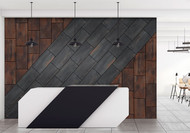How much better is a porcelain tile vs a ceramic tile?
Posted by Mike Belk on Jun 19, 2020

Why Porcelain Tiles Are a Good Choice For Your Home
Porcelain Tile continues to be the most popular choice among flooring consumers, according to an industry research report on the ceramics tiles market. According to the report, porcelain floor tiles remains the dominant product category as of 2019 and are estimated to see an compound annual growth rate of 7.3% from 2020 to 2017.
Why are these tiles the main choice among homeowners? Let’s start by looking at some of the advantages of using porcelain for your floors.
(:1f539:) Why use Porcelain Tiles?
Durability. This is an important consideration for homeowners since it means that they won’t have to replace their tiles as often over the life of their homes. Porcelain is recognized as being one of the most durable materials due to the way it is made.
The main ingredient used to make porcelain is clay, along with water, sand, quartz and feldspar. These ingredients are mixed together to create the body slip. The body slip is then dried and heated to reduce its moisture content from around 30% to six percent.
After this process, the body slip is essentially reduced to powder. This powder is then placed in a hydraulic or electric press to push it into the desired shape and size, under pressures ranging from several hundred pounds per square inch to as much as 100,000 pounds. This gives the tiles their tensile strength.
The tiles are fired in a kiln at temperatures between 1200-degrees C and 1400-degrees C, which vitrifies them. This process also gives them low porosity, making their water absorption less than 0.5 percent. Aside from being impenetrable to moisture, they are also stain-resistant and extremely rigid.
Of course, because of the way they are manufactured, porcelain tiles cost more upfront. But since they don’t need to be replaced as often, you are actually saving money in the long run.

Versatility. Porcelain’s durability also allows these tiles to be used either indoors or outdoors since they will be able to withstand all sorts of environmental conditions. They can even stand up to extreme weather for long periods of time.
Porcelain is also a good choice for areas that get high foot traffic, since they are scratch-resistant. For instance, if you do a lot of entertaining in your patio, porcelain floor tiles will still maintain their look even after heavy use.
In addition, since they can be made with abrasive grit in their glaze, they are slip-resistant. The risk of accidental falls is greatly reduced and they are much safer to walk on. If they get wet, simply mop the tiles to get rid of surface moisture.
Long-lasting. With the right installation and maintenance, porcelain tiles can theoretically last a lifetime. This is true for tiles that have a PEI of 5, which is recommended if they will be used as flooring in heavy traffic areas, such as public or commercial buildings. PEI is a rating that measures the hardness of the tile, with five being the highest rating.
However, even tiles with lesser quality can expect to have a maximum lifespan of twenty years. These may have a lower PEI of 2, which is suitable for indoor residential areas, such as living rooms, where people wear softer footwear such as slippers. If you install your tiles when your child is born, you won’t have to replace them until he is grown and ready for college.
Easy to clean. Since they are already waterproof, you don’t need to seal them. Spilt water will not cause any damage and you can simply mop it up.
Since dirt will not penetrate the tiles, all you have to do to clean them is to sweep with a soft broom when they get dirty. Then vacuum after you’re done to remove surface dirt. No waxing or polishing is required.
Available in a variety of styles. Porcelain floor tile can be made to look like other types of material such as marble, slate, limestone and even hardwoods. This provides you with a wide variety of options to choose from when buying tiles for your floor.
However, porcelain floor tiles do have some disadvantages. For instance, since the tiles are very hard, it can be very difficult for do-it-yourselfers to cut them unless they have the necessary equipment. You would need to hire a contractor to do the work for you.

In addition, since they are heavier than ceramic tiles, they may not be appropriate for use in upper floors. You would have to make sure that the structure is strong enough to support the extra stress porcelain floor tile would add.
However, these cons would be avoided with porcelain mosaic tiles. We will discuss these in a section below.
(:1f539:) What are the differences between Porcelain vs Ceramic Tiles?
Porcelain can actually be classified as atype of ceramic, since it is also made with clay. But unlike ceramics, which are made using white, brown or red clay, porcelain is made using white clay mixed with other substances.
Many people have trouble distinguishing between porcelain and ceramic tiles, and may even think of them as indistinguishable. But there are differences between the two that highlight how each type is appropriate for certain uses.
As a result, the water absorption rate of the two is also very different. Porcelain is required to have a rate of 0.5% or less while ceramics will absorb more water.
Here are some other ways that porcelain and ceramic tiles are different:
- Porcelain has a uniform color all throughout. If you look at a broken piece from a porcelain tile, you will notice it has the same color on the broken side. On the other hand, ceramic tiles have a glazed surface. This means that broken pieces may have a different color on the unglazed sections.
- Porcelain has a smoother finish all throughout. If you look at a piece of ceramic tile, you’ll notice that the unglazed side feels rough to the touch. On the other hand, porcelain tiles will feel smooth on both sides.
Of course, ceramic tiles are lighter and more affordable. This makes them the ideal choice for do-it-yourselfers, since these tiles are easier to cut, with readily available tools.
However, these tiles are not suitable for all uses due to their higher rate of water absorption. This is why many homeowners prefer to use ceramic for walls and porcelain for floors.
(:1f539:) What are the benefits of Porcelain Mosaic Tiles?
If you are looking for a way to add a unique look to your floors and walls, it’s time to consider porcelain mosaic tile. These consist of small pieces of cut tiles that have been arranged into an attractive pattern.
In the past, it was harder to achieve this mosaic effect. The carpenter would have to cut small pieces of tile manually, and then painstakingly arrange them into the desired pattern. Each piece would have to be individually glued into place.
These days, however, it is much easier since pre-designed porcelain mosaic tiles are already available. They are set on a mesh sheet to make installing them simpler. You can cut them with a wet saw that has a diamond blade. Individual tiles can be cut with tile nipper or tile snap cutter.
If you are interested in installing porcelain floor tiles, here are some things that you have to consider:
Make a design plan. Planning in advance will guide you as to the designs of the porcelain mosaic tile you will buy.
For instance, you can start by deciding on the theme you want for the room. This will help determine the color and style of the mosaic tiles you choose. You can also mix it up by using mosaics made with other materials, such as ceramic or glass, in certain areas of the room.
Measure properly. One thing most homeowners fail to consider is that an individual porcelain mosaic tile is offered in centimeters rather than inches. Hence, when they buy they frequently end up with too few tiles.
If possible, get a sample of the tile you are interested in. Then you can lay it down on the floor to see how it works with your planned décor. Doing this will also give you a rough idea of how many tiles you need.
Consider your budget. Since porcelain mosaic tiles can be pricey, you have to estimate how much the total cost will be so you’ll know if you can afford it.
When doing your cost estimate, keep in mind that you should buy 5% more tiles than you will actually need. You have to do this since you have to give allowance for breakage during installation.
If you are planning to do the work yourself, here are some handy tips.
Make sure that the surface you plan to install the tiles on is level. If the surface is irregular, then the final output will be unattractive, with some areas being slightly elevated while others are depressed.
Before you start, use a level to make sure the surface is perfectly straight. If there are dips, you can flatten them by placing on top of them some setting-style joint compound.
To make it easier to cut a porcelain mosaic tile, place it on a backer surface such as piece of plywood. This will prevent small pieces of tile from falling into the slot in the bed of the saw. Just make sure that you adjust the cutting depth so that the saw does not cut into the plywood.
Trim excess backing. If a piece of backing sticks out, it can cause you problems during installation. For instance, backing that protrudes from the edge of the tile can prevent you from ensuring that adjoining tiles fit together properly.
To avoid this problem, after cutting the tile, check to see if there is any backing sticking out from the edge. If there is, use a sharp utility knife to remove the excess.
You can cheat to fill in gaps. If there is a slight gap between the edge of the tile and a wall, and it is too narrow to fill with cut tile, there is a way you can cheat. You can spread the tiles slightly by using a utility knife to cut the mesh slightly. Then nudge the tiles into place with the edge of your trowel.
Tamp the tiles flat. By doing this after you’ve installed the tiles, you can ensure that the surface is completely flush and all the tiles are completely embedded.
But make sure that what you are using to do the tamping does not have a rough surface to avoid damaging the tiles. For instance, if you are using a block of wood, you can attach a thin sheet of rubber to one side.
The next time you renovate your house, keep porcelain tiles in mind since they are a worthwhile investment that will give you years of use while enhancing the appearance of your home.



